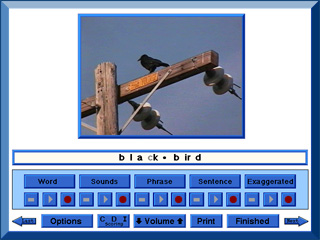
On Articulation I each target phoneme has 20 words in each of the initial, medial, and final positions. The 1,320 words are grouped by phoneme pairs into eleven categories.
Target Audience: Appropriate for ages 5–Adult for Articulation, Dialect Reduction, Apraxia, and Dysarthria.
WN21-1
$2.00
Articulation I: Consonant Phonemes
by LocuTour Multimedia
Articulation I: Consonant Phonemes (Windows)
Information for Professionals:
Disc 1 covers sounds that are often problematic for ages 4-7: p/b, t/d, k/g, f/v, th/th, sh/zh, ch/j, and m/n. Children with articulation problems love the colorful photos. Adults with aphasia or anomia appreciate the uncluttered direct therapy approach.
Disc 2 has the sounds that are often problematic for ages 6-10: th/th, s/z, sh/zh, l, and r. Because both l and r are commonly misarticulated, there are twice as many words in these two categories. Both discs can be used with adults with aphasia, apraxia, dysarthria, or anomia. These CDs are perfect for individual and small group therapy.
Drills do not have to be boring! The articulation series encourages practice of speech sounds by making the practice interesting. Listening to the word in isolation, the sounds of the word, the word in a phrase, and in a sentence allows practice at appropriate levels of complexity.
Photographs were chosen to appeal to children with developmental articulation disorders and to adults who are working on verbal expression. This program is an excellent choice for therapy for Oral Apraxia, Dysarthria, and Developmental Speech Disorders.
There are three titles in the series.
A large photo, buttons that determine the type of stimulus presented, and recording buttons make up the therapy screen. Clicking on the Word button says the word; the Sounds button models sound segmentation; the Phrase button says a phrase containing the word; the Sentence button says a sentence relating to the picture; and the Exaggerated button says the word with the target sound exaggerated. Monitoring progress is easy. The professional or client judges correct, distorted, and incorrect attempts. The computer tallies the results, which can be printed out or saved to disk for use in your word processing program.
For auditory memory or decoding practice, a toggle feature is included to hide/show words while the photo is on the screen. Five sets of recording buttons allow clients to record their imitations. The immediate feedback and non-threatening nature of the computer make it easy to elicit lots of high-quality productions. This is also an excellent format for small-group artic therapy sessions.
Options allow for personalized sessions. Clients can view the photos hierarchically or in random order. The words, phrases, and sentences can be displayed or hidden. Users can choose what the computer will say (word, sounds, etc.) when the picture first comes up on the screen. The clinician can use a “locking” feature to ensure that clients do not end the program before they are finished.